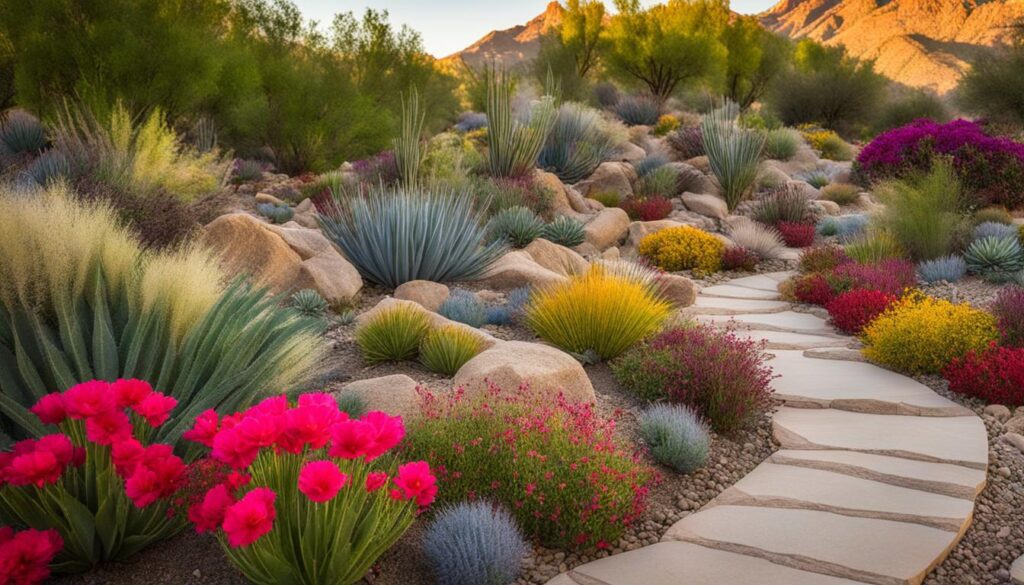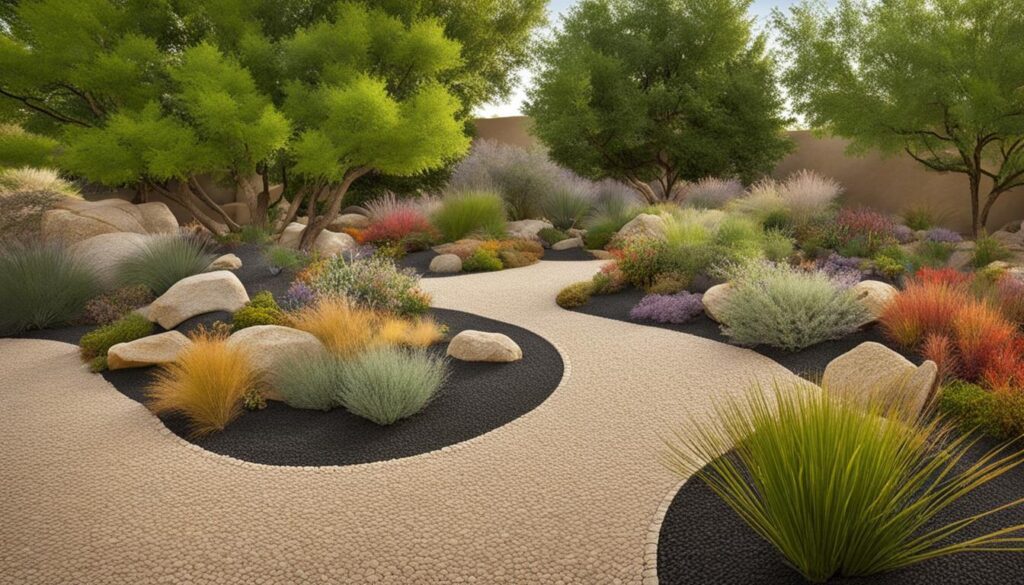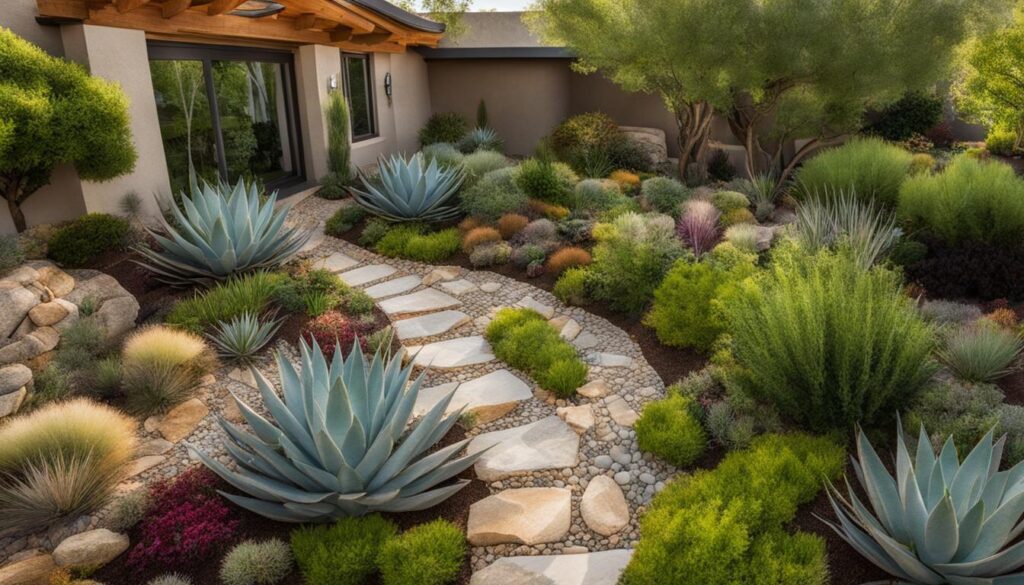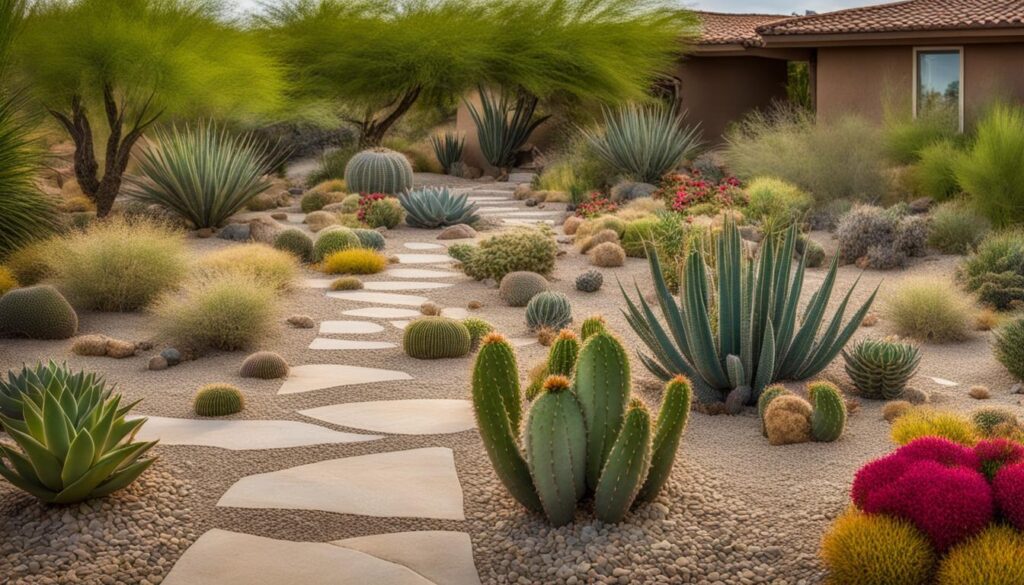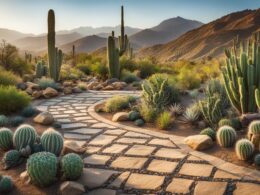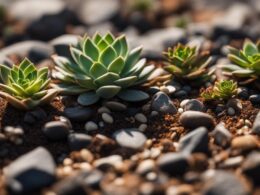Are you looking to create a beautiful and sustainable landscape while conserving water and minimizing maintenance? Xeriscape hardscape elements are the perfect solution. By incorporating gravel mulch, rock walls, and other hardscape features, you can design an aesthetically pleasing outdoor space that requires minimal care. However, proper care is crucial for maintaining the functionality and beauty of these elements.
Key Takeaways
- Xeriscape hardscape elements provide an environmentally friendly and low-maintenance landscaping solution.
- Proper care is essential for preserving the functionality and beauty of xeriscape hardscape elements.
- Xeriscaping offers benefits such as water conservation, reduced maintenance, and increased property value.
- The principles of xeriscaping, including water conservation and appropriate plant selection, are crucial for a successful design.
- Drought-resistant plantings, such as flowers, shrubs, and trees, are ideal for creating a sustainable xeriscape hardscape.
Benefits of Xeriscape
Xeriscaping offers several benefits that make it an attractive landscaping choice for homeowners. By incorporating xeriscape principles into your outdoor space, you can enjoy the following advantages:
- Water Conservation: One of the primary benefits of xeriscaping is its ability to save water. By reducing landscape water use, xeriscapes help conserve this precious resource.
- Less Maintenance: Xeriscape landscapes require less maintenance compared to traditional gardens. The use of drought-resistant plants and efficient irrigation systems eliminates the need for constant watering and upkeep.
- No Fertilizers or Pesticides: Xeriscapes rely on native or adapted plants that are well-suited to the local climate. These plants typically require minimal fertilizers or pesticides, resulting in a healthier and more environmentally friendly landscape.
- Increased Property Value: A well-designed xeriscape can enhance the curb appeal and value of your property. The sustainable and low-maintenance nature of xeriscapes is often seen as a desirable feature by potential buyers.
- Pollution-Free: Unlike traditional landscapes that may require chemical treatments and fertilizers, xeriscapes contribute to a pollution-free environment by reducing the use of harmful substances.
- Wildlife Habitat: Xeriscape gardens provide a habitat for local wildlife, including birds, butterflies, and beneficial insects. By incorporating native plants and creating diverse ecosystems, xeriscapes support biodiversity and contribute to a thriving natural environment.
By embracing xeriscape principles and enjoying these benefits, you can create a beautiful, sustainable, and water-efficient outdoor space that enhances the aesthetic appeal of your property while preserving the environment.
The Importance of Water Conservation in Xeriscape
Water conservation is a crucial aspect of xeriscaping. By implementing water-efficient practices, xeriscapes help to minimize water waste and promote sustainability. The following techniques can be employed to conserve water in your xeriscape garden:
- Drip Irrigation: Using drip irrigation systems ensures that water is delivered directly to the root zone of plants, minimizing evaporation and runoff.
- Mulching: Applying mulch around plants helps to retain soil moisture, reduce weed growth, and regulate soil temperature.
- Efficient Watering Schedule: Set up a watering schedule that aligns with the specific watering needs of your plants. Avoid overwatering, as it can lead to water waste and the risk of plant diseases.
- Rainwater Harvesting: Collecting rainwater in barrels or cisterns allows you to utilize natural precipitation for irrigation purposes, reducing the reliance on municipal water sources.
“Xeriscaping is not only beautiful, but it also offers environmental benefits that can make a positive impact on our communities. By reducing water consumption and embracing sustainable practices, xeriscapes contribute to a greener future.”
By adopting these water conservation techniques in your xeriscape garden, you can maximize the efficiency of water usage and create a thriving, environmentally conscious landscape.
Principles of Xeriscaping
When it comes to designing a xeriscape hardscape, there are seven key principles that you should keep in mind. These principles will help you create a water-efficient and low-maintenance landscape while still enjoying a beautiful outdoor space. Let’s explore each principle in detail:
1. Water Conservation
The first and most important principle of xeriscaping is water conservation. This involves using water wisely and efficiently to minimize waste. Implementing techniques such as drip irrigation and smart watering systems can help reduce water usage while still providing adequate moisture for your plants.
2. Soil Improvement
Healthy soil is essential for the success of any xeriscape hardscape. By improving the soil quality through techniques like adding organic matter and improving drainage, you can create an environment where plants can thrive with less water. Additionally, using mulch can help retain moisture and prevent erosion.
3. Limited Turf Areas
Avoiding extensive turf areas is another key principle of xeriscaping. Lawns require a significant amount of water and maintenance, so minimizing the area of turf can greatly reduce your water usage. Instead, consider incorporating drought-tolerant ground covers or other landscape elements that require less maintenance and water.
4. Appropriate Plants
Choosing the right plants for your xeriscape hardscape is crucial. Opt for native or drought-resistant species that are well-suited to your climate and soil conditions. These plants are adapted to thrive with less water and are generally low-maintenance, saving you time and effort in caring for your landscape.
5. Mulching
Mulching is an effective technique to conserve moisture and reduce weed growth in your xeriscape hardscape. Apply a layer of organic mulch around plants and in bare areas to help retain moisture, regulate soil temperature, and suppress weed growth. Mulching also adds an aesthetic appeal to your landscape.
6. Efficient Irrigation
Implementing efficient irrigation systems is essential for minimizing water waste in your xeriscape hardscape. Drip irrigation, micro-sprinklers, and smart timers can help deliver water directly to the root zone of plants, reducing evaporation and runoff. Regularly check and maintain your irrigation system to ensure optimal performance.
7. Maintenance
Maintaining your xeriscape hardscape is essential for its long-term success. Regularly inspect and make necessary repairs to your irrigation system, monitor plant health, remove weeds, and perform appropriate pruning and trimming. By staying on top of maintenance tasks, you can ensure that your xeriscape hardscape remains healthy and beautiful.
By following these principles of xeriscaping, you can create a sustainable and visually appealing hardscape design while conserving water and nurturing the environment. These principles work together to help you achieve a low-maintenance landscape that thrives in your local climate conditions. Now that you’re familiar with the principles, let’s move on to the next section to learn more about designing a xeriscape hardscape layout.
Designing a Xeriscape Hardscape Layout
When it comes to designing a xeriscape hardscape layout, there are several key factors to consider. By incorporating these elements into your design, you can create a beautiful and sustainable landscape that conserves water and requires minimal maintenance.
Water Conservation
One of the primary goals of xeriscaping is water conservation. To achieve this in your hardscape design, consider incorporating features such as permeable paving materials, which allow water to infiltrate the soil instead of running off. You can also install rainwater harvesting systems to capture and reuse rainwater for irrigation purposes.
Soil Improvement
Healthy soil is essential for the success of your xeriscape hardscape elements. Prior to designing your layout, test the soil to assess its fertility and drainage. If necessary, amend the soil with organic matter to improve its structure and water-holding capacity.
Appropriate Plant Selection
Choose plants that are well-suited to your local climate and soil conditions. Look for native or drought-tolerant species that require less water and maintenance. Group plants with similar water needs together to optimize irrigation efficiency.
Mulching, Irrigation, and Maintenance
Applying mulch around your hardscape elements helps to retain soil moisture, suppress weeds, and regulate soil temperature. For irrigation, consider using drip irrigation systems that deliver water directly to the plants’ roots, minimizing water loss through evaporation. Finally, regular maintenance, including pruning, weeding, and monitoring irrigation systems, is crucial to keep your xeriscape hardscape elements thriving.
By considering these design principles and incorporating them into your xeriscape hardscape layout, you can create a visually appealing and environmentally friendly landscape that conserves water and requires minimal upkeep.
Care and Maintenance of Xeriscape Hardscape Elements
Proper care and maintenance are crucial for preserving the integrity and longevity of your xeriscape hardscape elements. By following a few essential tasks, you can ensure that your xeriscape remains in pristine condition, while also reducing your overall maintenance efforts.
Clearing and cleaning the area is the first step in caring for your xeriscape hardscape elements. Regularly remove debris, such as fallen leaves and branches, to maintain a clean and visually appealing landscape. This helps prevent the buildup of organic matter, which can create a breeding ground for pests and diseases.
Pruning and trimming are important practices to promote the health and shape of your plants. Regularly trim back overgrown branches and remove dead or damaged foliage. This not only enhances the aesthetic appeal but also encourages proper growth and reduces the risk of disease or pest infestation.
Mulching and insulating play a vital role in protecting your xeriscape hardscape elements from extreme temperatures. Apply a layer of mulch around the plants and hardscape features to provide insulation and retain moisture. Mulch also helps suppress weed growth, conserves water, and improves soil quality.
Checking and repairing drip irrigation systems is essential for efficient water management in your xeriscape. Regularly inspect the drip lines for leaks or clogs, and repair any issues promptly. Ensuring proper irrigation helps conserve water and prevents overwatering or underwatering, which can stress plants and compromise the health of your xeriscape hardscape elements.
During the winter months, it’s important to provide proper care to protect your xeriscape hardscape elements from cold temperatures. Consider covering delicate plants with frost blankets or using insulating materials to shield them from frost damage. Additionally, adjust your irrigation schedule to account for reduced water needs during colder periods.
By following these essential care and maintenance tasks, you can enjoy a beautiful and sustainable xeriscape hardscape design that thrives with minimal effort.
Drought-Resistant Plantings for Xeriscapes
When designing a xeriscape hardscape, one of the key considerations is choosing the right drought-resistant plantings. These plants are specifically adapted to thrive in arid environments, making them ideal for water-efficient landscapes. Here are some popular options to consider:
Drought-Resistant Flowers:
- Lavender
- Yarrow
- Black-eyed Susan
- Sage
- Agastache
Drought-Resistant Perennials:
- Kniphofia (Red Hot Poker)
- Salvia
- Coreopsis
- Penstemon
- Blanket Flower
Drought-Resistant Shrubs and Trees:
- Manzanita
- Desert Willow
- Juniper
- Golden Barrel Cactus
- Olive Tree
Succulents:
- Agave
- Aloe
- Sedum
- Jade Plant
- Echeveria
Ornamental Grasses:
- Blue Fescue
- Maiden Grass
- Switchgrass
- Muhly Grass
- Pampas Grass
These are just a few examples of drought-resistant plantings that can thrive in xeriscapes. When selecting your plants, consider their water requirements, soil preferences, and climate adaptability. By choosing the right plantings, you can create a visually stunning and sustainable xeriscape hardscape that reduces water consumption and maintenance needs.
Quote:
“Drought-resistant plantings are the backbone of a successful xeriscape hardscape. They not only add beauty and color to the landscape but also conserve water and require minimal maintenance.” – Landscaping expert
Conclusion
Xeriscape hardscape care and maintenance are essential for creating and maintaining a sustainable, water-efficient, and low-maintenance landscape design. By following the principles of xeriscaping, selecting appropriate plants, and implementing proper care techniques, you can enjoy the benefits of xeriscape hardscape elements while conserving water and nurturing the environment.
Proper care is crucial for preserving the beauty and functionality of your xeriscape hardscape elements. Regular clearing and cleaning of the area will ensure a tidy and inviting landscape. To promote healthy growth, pruning and trimming plants is necessary. Mulching and insulating will protect your plants from extreme temperatures and retain moisture in the soil.
Checking and repairing your drip irrigation system is essential to prevent water waste and ensure that your plants receive the proper amount of hydration. Lastly, implementing winter care measures, such as covering sensitive plants and insulating pipes, will protect your xeriscape hardscape elements during colder months.
By dedicating time and effort to care for your xeriscape hardscape, you can create a beautiful and sustainable landscape that requires less water, maintenance, and resources. Embracing xeriscaping principles and selecting drought-resistant plants will not only benefit your property but also contribute to water conservation and the well-being of the environment.






